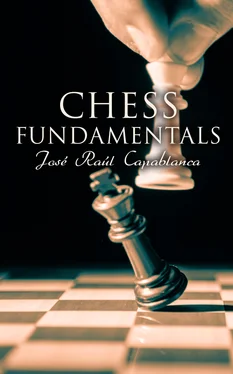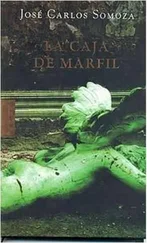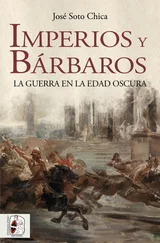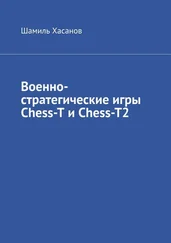5. RELATIVE VALUE OF THE PIECES
Before going on to the general principles of the openings, it is advisable to give the student an idea of the proper relative value of the pieces. There is no complete and accurate table for all of them, and the only thing to do is to compare the pieces separately.
For all general theoretical purposes the Bishop and the Knight have to be considered as of the same value, though it is my opinion that the Bishop will prove the more valuable piece in most cases; and it is well known that two Bishops are almost always better than two Knights.
The Bishop will be stronger against Pawns than the Knight, and in combination with Pawns will also be stronger against the Rook than the Knight will be.
A Bishop and a Rook are also stronger than a Knight and a Rook, but a Queen and a Knight may be stronger than a Queen and a Bishop.
A Bishop will often be worth more than three Pawns, but a Knight very seldom so, and may even not be worth so much.
A Rook will be worth a Knight and two Pawns, or a Bishop and two Pawns, but, as said before, the Bishop will be a better piece against the Rook.
Two Rooks are slightly stronger than a Queen. They are slightly weaker than two Knights and a Bishop, and a little more so than two Bishops and a Knight. The power of the Knight decreases as the pieces are changed off. The power of the Rook, on the contrary, increases.
The King, a purely defensive piece throughout the middle-game, becomes an offensive piece once all the pieces are off the board, and sometimes even when there are one or two minor pieces left. The handling of the King becomes of paramount importance once the end-game stage is reached.
6. GENERAL STRATEGY OF THE OPENING
The main thing is to develop the pieces quickly . Get them into play as fast as you can.
From the outset two moves, 1 P - K 4 or 1 P - Q 4, open up lines for the Queen and a Bishop. Therefore, theoretically one of these two moves must be the best, as no other first move accomplishes so much.
Example 17.—Suppose we begin:
|
1. P - K 4 |
P - K 4 |
|
2. Kt - K B 3 |
|
This is both an attacking and a developing move. Black can now either reply with the identical move or play
This developing move at the same time defends the King's Pawn.
These moves are of a purely developing nature.
It is generally advisable not to bring this Bishop out until one Knight is out , preferably the King's Knight. The Bishop could also have been played to B 4, but it is advisable whenever possible to combine development and attack.
Black replies in the same manner, threatening a possible exchange of Bishop for Knight with Kt × P to follow.
an indirect way of preventing 5...B × Kt, which more experience or study will show to be bad. At the same time the Rook is brought into action in the centre, a very important point .
Black follows the same line of reasoning.
These moves have a two-fold object, viz.: to protect the King's Pawn and to open the diagonal for the development of the Queen's Bishop.
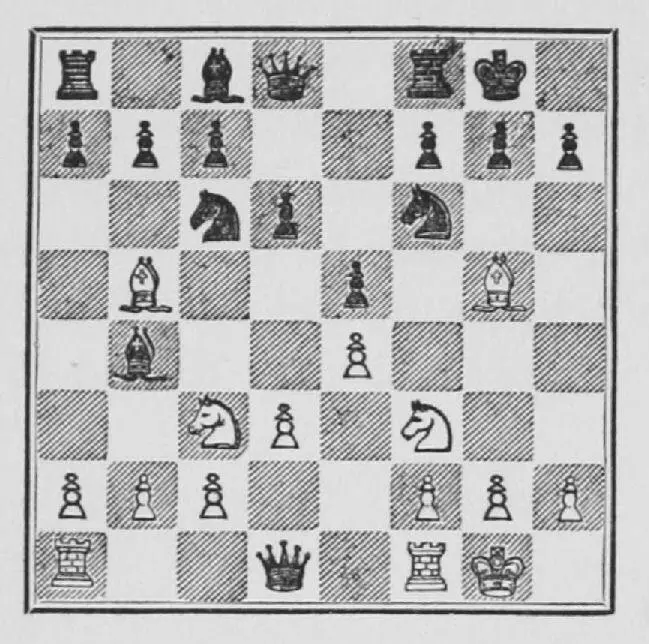
A very powerful move, which brings us to the middle-game stage, as there is already in view a combination to win quickly by Kt - Q 5. This threat makes it impossible for Black to continue the same course. (There is a long analysis showing that Black should lose if he also plays B - Kt 5.) He is now forced to play 7...B × Kt, as experience has shown, thus bringing up to notice three things.
First, the complete development of the opening has taken only seven moves. (This varies up to ten or twelve moves in some very exceptional cases. As a rule, eight should be enough.) Second, Black has been compelled to exchange a Bishop for a Knight, but as a compensation he has isolated White's Q R P and doubled a Pawn. (This, at such an early stage of the game, is rather an advantage for White, as the Pawn is doubled towards the centre of the board.) Third, White by the exchange brings up a Pawn to control the square Q 4, puts Black on the defensive, as experience will show, and thus keeps the initiative , an unquestionable advantage. 1
The strategical principles expounded above are the same for all the openings, only their tactical application varies according to the circumstances.
Before proceeding further I wish to lay stress on the following point which the student should bear in mind.
Before development has been completed no piece should be moved more than once, unless it is essential in order to obtain either material advantage or to secure freedom of action.
The beginner would do well to remember this, as well as what has already been stated: viz., bring out the Knights before bringing out the Bishops .
7. CONTROL OF THE CENTRE
The four squares, K 4 and Q 4 on each side respectively, are the centre squares, and control of these squares is called control of the centre. The control of the centre is of great importance. No violent attack can succeed without controlling at least two of these squares, and possibly three. Many a manœuvre in the opening has for its sole object the control of the centre, which invariably ensures the initiative. It is well always to bear this in mind, since it will often be the reason of a series of moves which could not otherwise be properly understood. As this book progresses I shall dwell more fully on these different points. At present I shall devote some time to openings taken at random and explain the moves according to general principles. The student will in that way train his mind in the proper direction, and will thus have less trouble in finding a way out when confronted with a new and difficult situation.
Example 18.
|
1. P - K 4 |
P - K 4 |
|
2. Kt - K B 3 |
P - Q 3 |
A timid move. Black assumes a defensive attitude at once. On principle the move is wrong. In the openings, whenever possible, pieces should be moved in preference to Pawns .
White takes the offensive immediately and strives to control the centre so as to have ample room to deploy his forces.
Black does not wish to relinquish the centre and also prefers the text move to Kt - Q B 3, which would be the more natural square for the Kt. But on principle the move is wrong, because it blocks the action of the Queen's Bishop, and instead of facilitating the action of Black's pieces, tends, on the contrary, to cramp them.
Black is forced to pay the penalty of his previous move. Such a move on Black's part condemns by itself any form of opening that makes it necessary. White threatened Kt - Kt 5 and Black could not stop it with 4...B - K 2, because of 5 P × P, Kt × P (if 5...P × P, 6 Q - Q 5); 6 Kt × Kt, P × Kt; 7 Q - R 5, and White wins a Pawn and has besides a perfectly safe position.
Читать дальше
